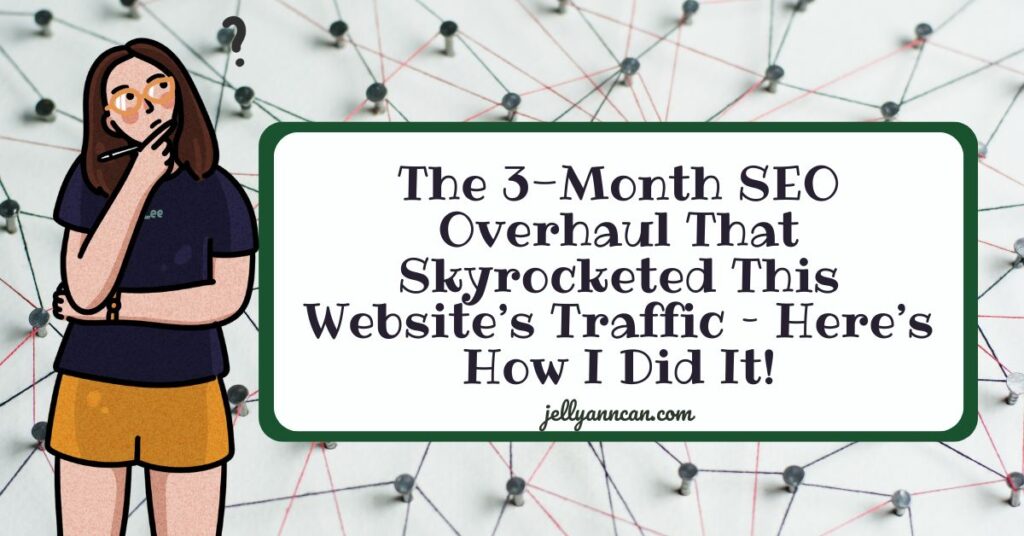SEO might seem like a slow, uphill climb, but sometimes all it takes is a little spark (that’s me!) to turn things around. In this case study, I’ll walk you through how I optimized a service-based website over just three months, implementing a new linking strategy, fixing technical issues, and publishing two articles a week. The result? In six months, the site saw a significant boost in traffic and visibility.
Whether you’re a business owner wondering if all this SEO stuff is actually working or an SEO professional looking to outsource, let me show you how a focused strategy can make all the difference.
The Results After 3 Months
- Total Clicks: 205 (Up from 181 in the previous three months)
- Total Impressions: 32.4K (Up from 21.5K)
- Average CTR (Click-Through Rate): 0.6% (Slight dip from 0.8%)
- Average Position: 34.9 (A slight boost from 35.3)
What Do These Numbers Mean?
- Clicks and Impressions: The site saw a nice increase in clicks, going from 181 to 205, but the real game-changer was the jump in impressions from 21.5K to 32.4K. That’s more people seeing the website in search results, which means more potential clients finding the business.
- Click-Through Rate (CTR): The CTR dropped from 0.8% to 0.6%, but don’t worry—it’s a natural side effect of more impressions. As more people see the site in searches, fewer might click. Next up, I’ll work on making those search result titles and descriptions more irresistible.
- Average Position: The average ranking position went from 35.3 to 34.9. I know, it sounds small, but even tiny jumps like this in SEO can lead to noticeable increases in traffic. This site is inching its way up the ranks, and that’s exactly what we want.
The Secret Sauce: My 3-Month SEO Strategy
Here’s how I turned things around for this site in just three months:
- Implemented a New Linking Strategy: Links are the backbone of SEO, so I rolled out a brand-new internal and external linking strategy. Internal links helped guide visitors (and Google!) through the site more effectively, while external links boosted the site’s credibility. This linking strategy gave the site more structure and improved its chances of ranking for target keywords.
- Fixed Technical Issues: Before getting fancy with content, I made sure to clean up the technical stuff. Page speed, mobile-friendliness, broken links—if it was hurting the user experience, I fixed it. A technically sound site is a must for SEO success, and once those issues were out of the way, the path was clear for growth.
- Published Articles Twice a Week: Consistency is key in content creation, so I set up a schedule to publish two blog posts every week. These weren’t just any posts—they were optimized, engaging, and targeted at the right audience. This steady stream of content gave the site more opportunities to rank for a variety of search terms, keeping it fresh in Google’s eyes.
Technical Issues and How I Fixed Them
When I first took a look at the website, it was clear that some technical issues were holding it back. These types of issues can affect everything from how search engines crawl your site to how fast users can interact with it. Here’s a breakdown of the main problems I identified and how I fixed them:
- Slow Page Speed:
- Issue: The website was taking too long to load, especially on mobile devices. This negatively impacted both user experience and search engine rankings.
- Fix: I optimized images, minified CSS and JavaScript files, and implemented browser caching. These changes reduced the page load time significantly, making the site faster and more responsive.
- Broken Internal Links:
- Issue: There were several broken links scattered across the website. These not only provided a poor user experience but also prevented search engine crawlers from indexing the site efficiently.
- Fix: I conducted a full audit of the site’s internal links and fixed or redirected the broken ones. This ensured a smoother user experience and better crawling by search engines.
- Unoptimized Mobile Experience:
- Issue: The site was not fully optimized for mobile devices, which led to formatting issues and a clunky experience for mobile users.
- Fix: I applied responsive design fixes, improving the layout and functionality across various screen sizes. This boosted the site’s mobile usability and search rankings.
- Duplicate Meta Descriptions and Title Tags:
- Issue: The site had duplicate meta tags on several pages, confusing search engines and hurting its rankings.
- Fix: I rewrote unique, keyword-optimized meta descriptions and title tags for each page, which helped the site rank better and attract more clicks from search results.
- Missing Alt Text on Images:
- Issue: Many images across the site lacked proper alt text, meaning they weren’t contributing to SEO and were less accessible to users with disabilities.
- Fix: I added descriptive alt text to all images, improving both SEO and accessibility.
- Site Structure Confusion:
- Issue: The site’s hierarchy was poorly organized, making it difficult for both users and search engines to navigate.
- Fix: I reorganized the site’s structure, making it more logical and user-friendly. This made it easier for visitors to find what they needed and allowed search engines to crawl the site more efficiently.
By addressing these technical issues, I improved the site’s overall performance and search engine friendliness, laying a solid foundation for the SEO strategy that followed.
Why This SEO Strategy Matters for a Service-Based Website
For a service-based website, visibility and leads are everything. Here’s how these results impact a business like this:
- More Leads: Every click represents a potential client. As the site shows up in more searches, the business gets more opportunities to capture leads. More impressions = more chances to convert searchers into clients.
- Better Local SEO Visibility: Service businesses thrive on local traffic. With my SEO strategy, the site started showing up more in local search results, meaning people nearby searching for services like theirs were much more likely to find them.
- Authority and Trust: By publishing consistent, high-quality content and fixing those technical issues, the website became more authoritative in its field. Both Google and potential clients trust sites that are well-maintained and regularly updated with helpful information.
How I Can Help Your Website
Whether you’re a business owner or an SEO professional, here’s how I can help you get results like this:
- Tailored SEO Strategy: I’ll design an SEO plan that’s specific to your needs. Whether you’re targeting local customers or a broader audience, I’ll help you rank higher and bring in more traffic.
- Content Creation That Works: I’ll handle the content side, making sure your site gets regular, optimized blog posts and updates. Consistency in content keeps your site active and helps you rank for more keywords.
- Fixing Technical SEO Issues: Don’t let technical problems drag your site down. I’ll optimize your site’s structure, speed, mobile compatibility, and more to ensure it’s performing at its best.
- Building a Strong Link Profile: Links are a major ranking factor, and I’ll focus on earning you high-quality backlinks and implementing internal linking strategies that improve your SEO over time.
Conclusion
In just three months of focused work—with a new linking strategy, fixing technical issues, and publishing blogs twice a week—I was able to drive significant growth for this service-based website. Traffic is up, visibility is improving, and the site is poised for even greater success.
For business owners, this case study shows that your web traffic can grow quickly with the right SEO strategy. For SEO professionals, this demonstrates how consistent, targeted SEO efforts can deliver measurable results in a short amount of time. I was the spark this website needed, and I’m ready to help your site catch fire too. Let’s ignite your SEO!







0 Comments